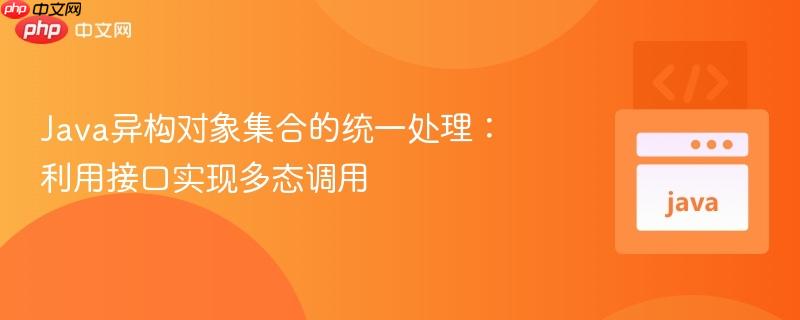
本教程探讨如何在java中优雅地管理和调用包含不同类型对象的集合。当需要对这些异构对象执行共同行为时,直接使用 `object` 类型会导致编译错误。核心解决方案是定义并实现一个共同的接口(如 `runnable` 或 `consumer`),使所有相关类遵循该接口规范,从而实现集合的类型统一和多态方法的安全调用。
在Java开发中,我们经常会遇到需要处理一组功能相似但类型各异的对象的情况。例如,你可能有一系列不同的任务类,它们都包含一个 run 方法来执行各自的逻辑,但这些类本身并没有直接的继承关系。如果试图将它们统一放入一个 HashSet<Object> 这样的集合中,并在迭代时调用其特有的方法,编译器会报错,因为 java.lang.Object 类本身并不包含这些特有方法。本文将深入探讨如何利用Java的接口机制,优雅地解决这一问题,实现异构对象集合的统一管理和多态调用。
设想你有以下两个不同的类 Something 和 Otherthing,它们都定义了一个 run 方法:
class Something {
public String name;
public String description;
public void run(String[] args) {
// Something特有的逻辑
System.out.println("Running Something...");
}
}
class Otherthing {
public String label;
public int priority;
public void run(String[] args) {
// Otherthing特有的逻辑
System.out.println("Running Otherthing...");
}
}如果你尝试将它们放入一个 HashSet<Object> 并调用 run 方法,会遇到编译错误:
import java.util.HashSet;
public class MainProblem {
public static void main(String[] args) {
HashSet<Object> things = new HashSet<>();
things.add(new Something());
things.add(new Otherthing());
// 编译错误:symbol: method run()
// location: variable thing of type java.lang.Object
// things.forEach(thing -> {
// thing.run(new String[]{}); // Object类型没有run方法
// });
}
}这是因为Java的编译器在编译时只知道 thing 是 Object 类型,而 Object 类并没有 run 方法。为了解决这个问题,我们需要为这些异构对象提供一个共同的“契约”或“行为规范”。
立即学习“Java免费学习笔记(深入)”;
解决上述问题的关键在于引入一个共同的接口。这个接口将定义所有异构对象都必须实现的方法,从而为集合提供一个统一的类型视图。
如果你的共同方法不接受任何参数且没有返回值(即 void run()),那么Java标准库中的 java.lang.Runnable 接口是一个非常合适的选择。Runnable 接口只包含一个抽象方法 void run()。
让我们修改 Something 和 Something2 类,使其实现 Runnable 接口:
// Something.java
public class Something implements Runnable {
public String name = "Something Task";
public String description = "A simple task definition.";
@Override
public void run() {
System.out.println(name + " is running. Description: " + description);
}
}
// Something2.java
public class Something2 implements Runnable {
public String name = "Something2 Task";
public String description = "Another simple task definition.";
@Override
public void run() {
System.out.println(name + " is running. Description: " + description);
}
}现在,这两个类都实现了 Runnable 接口,它们都保证提供了 run() 方法。因此,我们可以创建一个 HashSet<Runnable> 来存储它们,并安全地调用 run() 方法:
import java.util.HashSet;
public class MainSolutionRunnable {
public static void main(String[] args) {
HashSet<Runnable> things = new HashSet<>();
things.add(new Something());
things.add(new Something2());
System.out.println("Executing tasks using Runnable interface:");
things.forEach(Runnable::run); // 使用方法引用或者lambda表达式
// 等同于 things.forEach(thing -> thing.run());
}
}输出示例:
Executing tasks using Runnable interface: Something2 Task is running. Description: Another simple task definition. Something Task is running. Description: A simple task definition.
(输出顺序可能因HashSet内部实现而异)
通过将集合的类型声明为 Runnable,编译器现在知道集合中的每一个元素都必然拥有 run() 方法,从而解决了编译错误。
原始问题中的 run 方法定义是 public void run(String[] args),它接受一个 String 数组作为参数。在这种情况下,Runnable 接口就不适用了,因为它定义的 run() 方法不带参数。
对于需要接受一个参数且没有返回值的方法,java.util.function.Consumer<T> 接口是更合适的选择。Consumer<T> 接口包含一个抽象方法 void accept(T t)。
如果你的方法需要接受 String[] args,你可以将接口定义为 Consumer<String[]>,并实现其 accept 方法。
import java.util.function.Consumer;
// TaskWithArgs.java
public class TaskWithArgs implements Consumer<String[]> {
public String taskName;
public TaskWithArgs(String taskName) {
this.taskName = taskName;
}
@Override
public void accept(String[] args) {
System.out.print(taskName + " is running with arguments: ");
if (args != null && args.length > 0) {
for (String arg : args) {
System.out.print(arg + " ");
}
} else {
System.out.print("None");
}
System.out.println();
}
}
// AnotherTaskWithArgs.java
public class AnotherTaskWithArgs implements Consumer<String[]> {
public String taskName;
public AnotherTaskWithArgs(String taskName) {
this.taskName = taskName;
}
@Override
public void accept(String[] args) {
System.out.print("Another task (" + taskName + ") processing arguments: ");
if (args != null && args.length > 0) {
System.out.println(String.join(", ", args).toUpperCase());
} else {
System.out.println("No arguments provided.");
}
}
}现在,我们可以创建一个 HashSet<Consumer<String[]>> 来管理这些带参数的任务:
import java.util.HashSet;
import java.util.function.Consumer;
public class MainSolutionConsumer {
public static void main(String[] args) {
HashSet<Consumer<String[]>> tasks = new HashSet<>();
tasks.add(new TaskWithArgs("File Processor"));
tasks.add(new AnotherTaskWithArgs("Data Analyzer"));
String[] argumentsForTasks = {"input.txt", "output.log", "debug"};
System.out.println("\nExecuting tasks using Consumer<String[]> interface:");
tasks.forEach(task -> task.accept(argumentsForTasks));
}
}输出示例:
Executing tasks using Consumer<String[]> interface: Another task (Data Analyzer) processing arguments: INPUT.TXT, OUTPUT.LOG, DEBUG File Processor is running with arguments: input.txt output.log debug
(输出顺序可能因HashSet内部实现而异)
自定义接口: 如果 Runnable 或 Consumer 无法满足你的方法签名(例如,需要返回值,或者多个参数,或者不同类型的参数),你可以定义自己的函数式接口。
@FunctionalInterface
interface MyCustomAction {
String execute(int id, String message);
}然后让你的类实现 MyCustomAction。
Lambda 表达式: 对于简单的、无需维护状态的单方法实现,可以直接使用 Lambda 表达式来创建接口实例,而无需定义完整的类。这在某些场景下可以极大地简化代码。
import java.util.HashSet;
import java.util.function.Runnable;
public class MainLambda {
public static void main(String[] args) {
HashSet<Runnable> tasks = new HashSet<>();
// 使用Lambda表达式创建Runnable实例
tasks.add(() -> System.out.println("Lambda Task 1 running!"));
tasks.add(() -> {
System.out.println("Lambda Task 2 running!");
// 可以在这里添加更复杂的逻辑
});
System.out.println("\nExecuting tasks created with Lambdas:");
tasks.forEach(Runnable::run);
}
}属性管理: 在原始问题中,类中包含 name 和 description 等属性。当使用接口时,这些属性仍然属于实现接口的特定类实例。在 run() 或 accept() 方法内部,你可以访问这些实例属性,就像在上面的 Something 和 Something2 示例中那样。
接口的单一职责原则: 设计接口时,应遵循单一职责原则。一个接口最好只定义一组相关的功能。这有助于提高代码的可读性、可维护性和复用性。
泛型接口: 如果你的共同方法需要处理不同类型的数据,可以考虑使用泛型接口来增加灵活性。例如,Consumer<T> 就是一个泛型接口。
在Java中,当需要对一个包含不同类型对象但共享共同行为的集合进行统一操作时,核心策略是利用接口实现多态性。通过定义一个共同的接口(无论是Java标准库提供的 Runnable、Consumer 等函数式接口,还是自定义接口),并让所有相关的类实现该接口,我们可以将集合的类型声明为该接口类型。这不仅解决了编译时类型检查的问题,还极大地增强了代码的灵活性、可扩展性和可维护性。理解并熟练运用接口是Java面向对象编程中不可或缺的一环,它使得我们能够编写出更加健壮和优雅的程序。
以上就是Java异构对象集合的统一处理:利用接口实现多态调用的详细内容,更多请关注php中文网其它相关文章!

每个人都需要一台速度更快、更稳定的 PC。随着时间的推移,垃圾文件、旧注册表数据和不必要的后台进程会占用资源并降低性能。幸运的是,许多工具可以让 Windows 保持平稳运行。

Copyright 2014-2025 https://www.php.cn/ All Rights Reserved | php.cn | 湘ICP备2023035733号